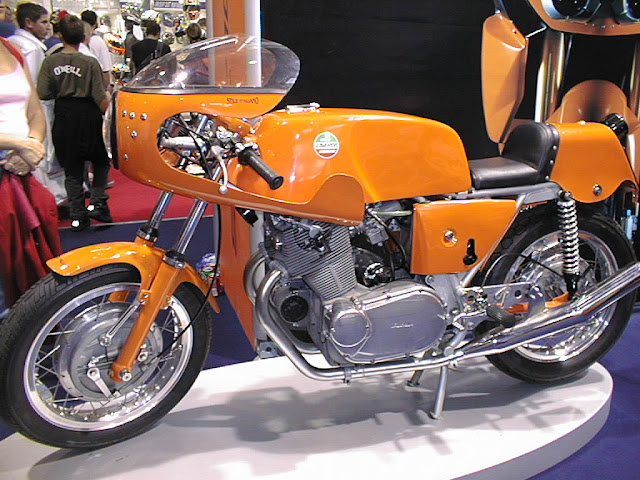Laverda 750 SFC
One glance at the Laverda 750 SFC was enough to reveal why the Italian twin made an impact out of all proportion to the small number of machines that were produced. The SFC was hugely stylish and racy, with clip-on handlebars, rearset footrests, a half-fairing and single seat. Its bodywork was orange, because that colour made the model easier to spot at night during the 24-hour endurance races for which it was created.
Unlike most so-called race replicas, the 750 SFC really was a racebike first and a roadster second. It was launched in 1971 as an endurance racing version of Laverda’s SF series of 750cc parallel twins. Despite this, a large proportion of the 549 SFCs built in the following few years were ridden on the street, after fitment of such essentials as speedometer and number plate.
Laverda, the small firm from Breganze in north-eastern Italy, had first produced a 654cc parallel twin in 1967, before enlarging the motor to 744cc a year later. In 1969 the factory had introduced a sportier 750S model, which in turn had been followed by the 750 SF (F standing for freni, Italian for brakes, due to its uprated drums). These models had been campaigned on European endurance race circuits with some success. But the firm’s boss, Massimo Laverda, decided that a purpose-built racer was needed so the SFC was bom, the C of its name standing for Competizione.
Although it shared the SF’s basic engine layout, which meant dimensions of 80 x 74mm, a 360- degree crankshaft and chain drive to the single overhead camshaft, the SFC shared few components. Special parts included high-smsa compression pistons, 36mm Amal carburettors and a close-ratio five-speed gearbox. Engine parts were selected by Laverda’s race shop before being heat- treated to improve strength. Peak output was a claimed 70bhp at 7500rpm, enough for a top speed of I25mph (201km/h).
Similarly the SFC frame shared the original twin’s layout of a spine made from four steel tubes above the engine, but was modified to take the fairing and rear-set footrests. Initial models featured Ceriani front and rear suspension plus Laverda’s own drum brakes. The combination proved a success, as the SFC won its first race, the Barcelona 24 Hours at Montjuic Park in 1971.
For the next few years the SFC was one of the fastest bikes on the road, and one of the best handling too. But the high specification ensured that it was expensive, and fewer than 100 were built in each of the first three years. In 1974 Laverda subtly reshaped the bodywork and fitted uprated parts including thicker forks and triple disc brakes. Production numbers increased slightly, and some bikes were built for road use with full instruments and even indicators.
Later SFCs featured electronic ignition and some had cast wheels too. The last models were the fastest, especially when fitted with the optional factory camshaft that gave extra power and a top speed of I35mph (2l7km/h). Fittingly, the SFC’s racy look, paint scheme and personality remained very much intact until production ended in 1976.
The SFC's 744c aircooled sohc parallel twin engine looked similar to other Laverda units, but featured specially selected tuning parts. It was also fitted with bigger carbs, a close-ratio gearbox, uprated bearings and a larger capacity oil pump.
One-race Wonder: the Mighty V6
Laverda's fastest ever bike was another orange endurance racer: the 996cc V6 that was raced in the Bol d'Or 24 Hours in France in 1978. The 90- degree V6 unit featured 24 valves, liquid cooling and shaft final drive, and produced 139bhp at 10,500rpm. Although very heavy at 520lb (236kg), the V6 was stunningly fast, and was timed at 176mph (283km/h) before its drive shaft failed after eight hours. Laverda's financial problems meant that it did not race again, and a roadgoing version was never produced.
Specification Laverda 750 SFC (1972)
- Engine Air-cooled sohc four-valve parallel twin
- Capacity 744cc (80 x 74mm)
- Maximum power 70bhp @ 7500rpm
- Transmission Five-speed, chain final drive
- Frame Tubular steel spine
- Suspension Telescopic front; twin shocks rear
- Brakes Drum front and rear
- Weight 454lb (206kg)
- Top speed 125mph (201 km/h)





















![Bridgestone Logo, HD, Png and Vector Download Desk Screen [Jan-2018] Bridgestone Logo, HD, Png and Vector Download Desk Screen [Jan-2018]](https://4.bp.blogspot.com/-7vi_XzJzKuw/WeGVPjZaVcI/AAAAAAAAOcE/VDyGdVh4E6gwAvSR9qKoNvCTbdAop6MgACLcBGAs/w110-h90-c/bridgestone%2Bb%2BLogo%2BVector%2Bwallpaper.jpg)

0 comments: